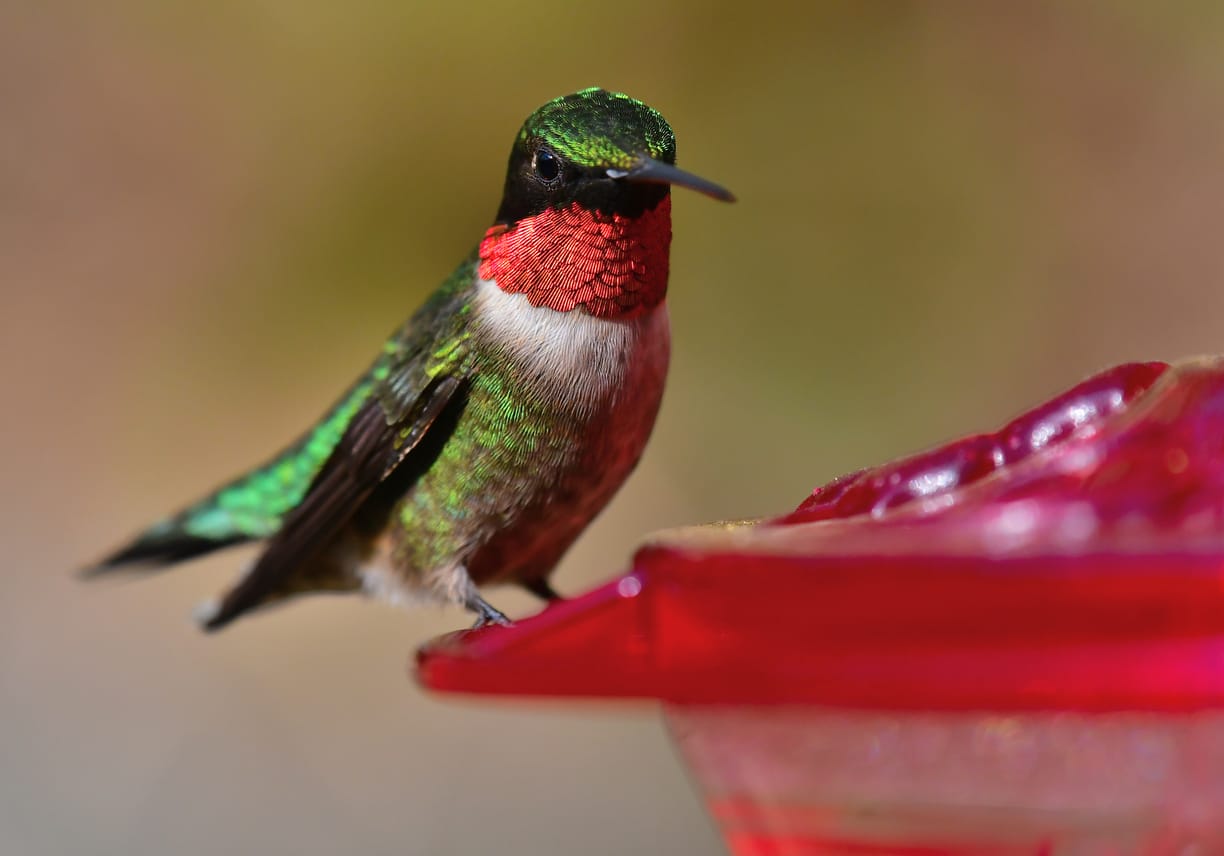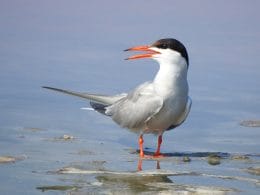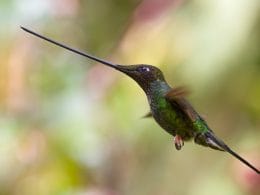The State of Florida is a major tourist hotspot due to its wide range of beautiful beaches and attractions.
However, in addition to all that, it’s also a wonderful spot for bird watchers and nature lovers to witness some of the most amazing birds out there, even from the comfort of your own backyard!
In fact, according to the Florida Ornithological Society Records Committee (FOSRC), there are 536 recorded species of birds that call the Sunshine State home!
In today’s article, we’ll walk you through 15 of the most common Florida backyard birds that you can find out there!
1. Northern Cardinal

Despite the name, the Northern Cardinal is one of the most common Florida backyard birds! Not only that, but it’s also found in Florida throughout the year because, like other cardinals, these birds don’t migrate in summer!
Luckily, the common bird is also one of the most beautiful birds that you can find out there. The males rock a flaming red plumage that covers most of their bodies along with a black mask at the eyes and throat.
Females, on the other hand, are fairly dull with tan feathers along with some reddish hues here and there. However, both birds rock a reddish orange crest that makes them very easy to identify.
Author Note: Northern Cardinals are fairly adjusted to residential areas and will land in backyards that have any bird feeders, whether it’s hopper-based, ground tray, or any other kind.
They mainly feed on sunflower seeds, millet, mixed seeds, or peanut hearts.
2. Tufted Titmouse

Next up, we have one of the very common birds that share a common crest with the North Cardinal, despite rocking a completely different set of colors.
The Tufted Titmouse is gradient silver-gray on the back that fades until white at the belly with a small bluish-gray crest. The bird also has a small black patch above its tiny peak.
Like the cardinal, the titmouse is found in Florida all year round, especially Northern Florida, as they’re not as common in the south.
The bird is fairly assertive over other titmice and other smaller birds around the feeder, but will often flock with nuthatches, woodpeckers, and chickadees.
To attract tufted titmice to your platform or tube feeder, you need to fill it with suet, black oil sunflower seeds, and peanuts.
3. Painted Bunting

Another common Florida backyard bird is the painted bunting. ThePainted Bunting may not be the most common backyard bird in Florida, but it’s easily the most colorful of the bunch! The bird typically visits Florida in the winter and remains in the south.
The male of these birds are characterized by the green back and tail, blue head, red bellies, and rump, along with touches of yellow here and there to give them an unmistakable and surprisingly brilliant look!
The females of this species are considerably more beautiful than many other birds, but they’re far less colorful than their respective males! They’re mostly olive green with yellow bellies and have a fairly stocky appearance.
While these birds typically feed on regular seeds and insects, they’re extremely timid and elusive because of how easy they’re to spot, so you’d be extremely lucky to come across one!
4. Mourning Dove

The Mourning Dove is one of the most common birds that visit backyards. You can often find the bird perching in groups, especially around low-hanging trees and telephone wires.
However, as ground feeders that mostly feed on fallen seeds, they’re most commonly seen walking on the ground.
The birds are attracted to ground feeders or sheperds hook feeders, but you can also bring them to your backyard by scattering millet and seeds around your yard.
Mourning Doves have an unmistakable tubby appearance with a size similar to that of robins and you can typically find these birds all year round and all over the state.
The bird is known for its pale brown or buff color along with freckling on the wings and a bright bluish ring around its eyes.
5. Red-winged Blackbird

The Red-winged Blackbird is one of the easiest birds to identify because they’re quite abundant and have a unique appearance that sets them apart from other blackbirds.
As the name suggests, the bird has a glossy all-black appearance in addition to a bright red and yellow patch on the top of its wings and a pointed peak. Females of the species are typically brown with heavy white streaks at the belly.
Author Note: Red-winged Blackbirds are typically found all over the state and throughout the year. The birds also don’t have a specific preference when it comes to food or bird feeders.
They’ll typically eat just about any kinds of seeds, suet, or millet they’re offered from any type of feeders, which is one of the reasons why these species are quite common all over the country.
6. Red-bellied Woodpecker

The Red-bellied Woodpecker is one of the fairly common woodpeckers that you can find in Florida and they typically like to hang around bird feeders.
Despite the name, the bird’s most characteristic features are the bright red stripe that runs at the back of its head along with the checkered pattern on its wings. The rosy red patch on the belly is quite faint but fairly noticeable up close.
Like many woodpeckers, the bird mainly feeds on insects and small fish in nearby ponds, but can also land on your tray feeders for a quick meal of suet and crushed peanuts.
In addition to their adaptability to bird feeders, they can also build their nests in bird boxes nearby.
7. Yellow-rumped Warblers

The Yellow-rumped Warblers are the most widely common new world warblers in the entire region, including Florida. The stocky male is grayish olive with several streaks of yellow on its rump in addition to the face and sides.
Females, on the other hand, are relatively brownish with bright yellow rumps. Keep in mind that these birds turn bright yellow and grey only in the spring during the breeding season.
The birds spend most of their breeding season in Canada and then migrate in large flocks to the south, including Florida as well as the Caribbean and most of Central and South America.
In Florida, the birds usually spend the winter in relatively open areas overlooking fruiting shrubs because they mostly eat fruits in winter.
Yet, you can attract some of these birds to your yard by using suet, raisins, berries, sunflowers seeds, and peanuts.
8. Northern Mockingbird

The Northern Mockingbird is characterized by its relatively small head and long tail, despite being a medium sized bird. It’s also been considered the national bird of Florida since 1927.
The songbird is mostly brownish gray with a whitish belly and a grayish back along with indefinable white wing bars that you can easily notice when they fly.
The bird lives up to its name, the male mockingbirds can learn and copy up to 200 different bird songs throughout their life.
Northern Mockingbirds rarely visit bird feeders, but they may land in your backyard if you have a large lawn and plant fruiting bushes and trees, such as blackberry brambles, mulberries, and hawthorns.
9. American Goldfinch

American Goldfinches are among the most common and prettiest birds that will land in your backyard, and luckily, they’re abundant in the state of Florida throughout the year.
The birds are typically easy to recognize, especially during the summer. This is because they change to unique black and golden yellow colors that cover their body, cap, and wings.
In winters, the bird usually molts and changes to a rather dull coat that is mostly dark olive and brown, which makes them less recognizable.
The bird has a characteristic black peak that allows them to eat seeds and suet, so you can attract them to your feeder using these types of food.
10. Blue Jay

Blue Jays are among the most beautiful and distinct songbirds in Florida. The bird is considered a nuisance to some bird watchers because Blue Jays are quite loud and imitate the call of hawks to scare off other birds.
However, they have a remarkably attractive coat of plumage that makes up for their annoying calls. The bird rocks strikingly bright blue feathers that cover most of the bird’s back along with a white belly and striped black and blue wings.
Additionally, the bird has an upright blue crest that makes males identifiable. Blue Jays feed on suet and sunflower seeds, so you can use these kinds of food to lure them into your backyard.
Moreover, they’re incredibly smart, being among a very few species of birds that can crack a nut open!
11. American Robin

American Robins are quite popular and considered a favorite to many birders and enthusiasts, and luckily, they’re also a fairly abundant bird that often lands in backyards while foraging for mealworms and insects.
The bird has a unique coat of bright orange-red belly along with a dark brown or black back and a small yellow peak. This makes them quite easy to identify and spot. They also lay beautiful sky blue eggs that make their nest characteristic as well.
Unlike many other birds, American Robins find it difficult to crack the hard shell of seeds open, so you can either provide them with berries, hulled seeds, crushed peanuts, or millet.
Robins are also huge fans of bird baths, so you’re almost guaranteed to attract them if they’re nearby and you have one in your backyard.
12. Eastern Bluebird

The Eastern Bluebird is known for its relatively large eyes, bellies, and heads. Despite that, The bird is one of the most attractive birds that the East Coast has to offer, rocking a deep blue feather coat that mainly covers the bird’s back.
The bird is also characterized by its faint hue of reddish bronze ib belly. These patterns and colors are also shared by the female eastern bluebird. Yet, females are noticeably less vibrant than males.
Top Tip: Both males and females enjoy perching on low hanging branches as well as fence posts while searching the area for insects.
Yet, you can attract Eastern Bluebirds to bird feeders by offering mealworms. You can also provide them with a small bird box if you have a large lawn so they can feed on insects in the area.
13. White-breasted Nuthatch

The White-breasted Nuthatch is also quite common in Florida. Despite the bird’s small size and tail, it has a relatively long peak along with a bluish-gray plumage that covers the bird’s back.
The underside of the bird features a white breast and belly. Nuthatches usually perch on small groups on fence posts while foraging for insects. Yet, you can attract them to your backyard with seeds, millet, mealworms, and berries.
14. Florida Scrub-Jay

These birds are quite similar to regular Blue Jay, as they’re also blue and white in color. They also share a similar appetite for insects and small vertebrates and invertebrates.
The Florida Scrub-Jay is the only bird that is almost exclusively found in Florida. However, like the painted bunting, they’re quite rare to find outside a few regions in the state.
Luckily, however, they’re very likely to land in bird feeders with any types of seeds and peanuts. They also don’t migrate, so you’ll be able to spot them there all year round!
15. Ruby-throated Hummingbird

The Ruby-throated Hummingbird is easily the most common type of hummingbird in all of the Nation, including the entire state of Florida.
Top Tip: The bird is a regular visitor of nectar feeders, especially during the breeding season from April to May.
The males are known for their mesmerizing ruby-red plumage in the throat area along with the iridescent emerald green on their wings, back, and head.
Females of the species don’t have the characteristic ruby-red plumage but share similar characteristics in terms of the green-colored plumage pattern.
Final Words
With that said, you now have a brief guide that walks you through some of the most beautiful and common backyard birds that you should expect to see when you’re in Florida.
Always keep in mind that these are the most common birds that you’re likely to come across in Florida, so you can stumble across rarer and even more exquisite birds!
FAQ
That would have to be the Northern Cardinal. It is probably the most common bird where ever it lives.
The Sandhill Crane stands at 1.2 meters tall and so, is the tallest flying bird. The heaviest flying bird would be the American White Pelican, weighing in at 30 pounds. Despite that, it is an excellent flyer.
That depends on what you mean by exotic. eBird has classed birds that have been introduced to an area as exotic. For instance, the Black Swan is classed as exotic in Florida. Now, if you mean exotic as in tropical, rare or colorful, that would have to be something like the Golden-fronted Woodpecker.










